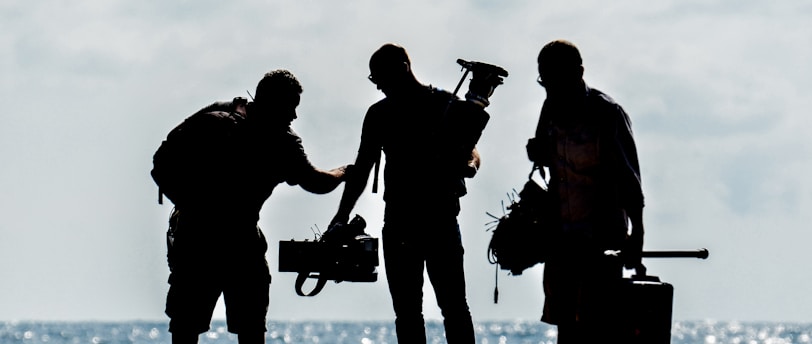The Different Crew Positions and Roles on Set
This blog post breaks down the various crew roles on a film set, from the key decision-makers to those who ensure everything runs smoothly behind the scenes. If you're entering the film industry or looking to better understand how films are made, this guide will provide a comprehensive overview of the essential crew positions.
1/11/20255 min read


Working in the film industry requires an understanding of the various crew positions on set. When you’re starting out, it can be overwhelming to navigate the wide range of roles, but gaining familiarity with the film crew hierarchy is a great place to start. Each film production is a well-oiled machine, and every crew member plays a vital part in bringing a project to life.
One of the first things you’ll come across when discussing film set terminology is the distinction between “above the line” and “below the line” positions. These terms come from traditional budgeting practices, where a literal line divided the crew into two categories: those paid a fixed salary and those paid on an hourly or daily basis. But beyond the financial distinction, the terms also represent the two main levels of responsibility and creative input within a production.
Let’s take a closer look at these positions, break them down by their departments, and highlight what each role entails.
Above the Line Crew
Above the line positions generally involve the more creative and financial responsibilities in a film production. These key figures make major decisions that impact the overall project from start to finish, and they typically work throughout the entire production process—from pre-production all the way through to post-production.
1. Director
The director is arguably the most critical creative figure on a film set. They are responsible for bringing the script to life, working with the actors to shape their performances, and collaborating with various departments to ensure that the film maintains a cohesive vision. Directors oversee the film's visual style, tone, and pacing, and they are deeply involved in the post-production process, especially during editing.
2. Producer
Producers manage the logistical side of filmmaking. They handle budgets, schedules, and resources, and they ensure the film stays on track financially and creatively. Often, producers secure financing and put together the necessary team of professionals to make the project happen. Without a good producer, a film would struggle to move from concept to completion.
3. Executive Producer
While similar to a producer, the executive producer generally handles the business side of things, such as securing funding, distribution, and overseeing the project from a higher level. Executive producers may not be involved in the day-to-day operations of a film, but their contributions are essential in getting the project off the ground.
4. Principal Cast
The principal cast includes the main actors who play the key characters in the story. These individuals often have a significant amount of influence over the direction of the production, as their performances are integral to the success of the film.
5. Casting Director
Casting directors are responsible for selecting the right talent for each role in a film. They work closely with the director and producer to ensure that the actors chosen for the roles fit the vision of the film and help bring the characters to life. A good casting director can make or break a project by ensuring the chemistry and dynamics among the cast are just right.
Below the Line Crew
The bulk of the work on set is done by the below the line crew, who handle all the practical and technical aspects of filmmaking. These roles are often department-specific and require specialised skills to execute the director’s vision. Below the line positions can be broken down into various departments, each with their own structure and hierarchy.
1. Art Department
The art department is responsible for everything you see on screen that isn’t the actor or the camera. From sets to props to costume design, the art department is crucial in establishing the look of the film.
Production Designer: The production designer creates the visual concept for the film, working closely with the director to bring the world of the film to life.
Art Director: The art director manages the construction of sets, props, and costumes, ensuring that everything aligns with the production designer's vision.
Set Dresser: Set dressers prepare the set, placing furniture, decorations, and props to create a believable environment.
Prop Master: The prop master is responsible for sourcing, managing, and sometimes creating props used by the actors during filming.
2. Camera Department
The camera department handles everything to do with capturing the footage. The camera crew works in tandem with the director of photography (DoP) to ensure each shot is framed, lit, and executed to perfection.
Director of Photography (DoP): The DoP is in charge of the film’s visual style, including lighting, camera placement, and shot composition. They collaborate with the director to achieve the look and mood of the film.
Camera Operator: The camera operator is responsible for physically operating the camera during the shoot. They execute the director's instructions on framing and camera movement.
1st AC (Assistant Camera): The 1st AC manages the camera equipment, focuses the lens during shooting, and ensures everything is working smoothly.
2nd AC: The 2nd AC assists with camera setups, marks the actors' positions, and manages the film slate (clapperboard).
DIT (Digital Imaging Technician): The DIT ensures the digital files are safely recorded, backed up, and processed. They manage the digital workflow, ensuring no data is lost during the shoot.
3. Grip and Electric Department
This department is essential for creating the perfect lighting environment. Grips manage the physical set pieces that affect the lighting, while the electrics handle the actual lighting equipment.
Gaffer: The gaffer is the head of the electric department and works closely with the DoP to design the lighting setup for each scene.
Best Boy Electric: The best boy is the gaffer's right-hand person, assisting with the management of lighting equipment and crew.
Key Grip: The key grip oversees the manipulation of light and shadow, using flags, reflectors, and other tools to shape the light for the DoP.
Best Boy Grip: Similar to the best boy electric, this person manages the grip crew and equipment, ensuring everything runs smoothly on set.
4. Hair and Makeup
Hair and makeup artists ensure that talent is camera-ready. Their work can also include creating special effects makeup for specific characters or scenes.
Key Makeup Artist: The key makeup artist designs and applies the makeup for the cast, ensuring continuity and alignment with the director's vision.
Key Hair Stylist: Similar to the makeup artist, the hair stylist is responsible for the appearance of the cast's hair, ensuring it's suitable for the role and the scene.
Special Effects Makeup Artist: This specialist applies prosthetics, body paint, and other special effects makeup to create transformations and enhance the visual storytelling.
5. Sound Department
The sound department captures all the audio on set, ensuring clarity and quality. They work to record dialogue, sound effects, and other crucial sound elements.
Production Sound Mixer: The sound mixer ensures that all dialogue and sound effects are captured clearly on set, balancing audio levels as required.
Boom Operator: The boom operator is responsible for holding and positioning the microphone during filming to capture the best sound.
Sound Assistant: This role helps with setting up equipment and running cables, ensuring the sound department has everything they need to work effectively.
6. Production Department
The production team is the backbone of the entire operation, overseeing logistics, scheduling, and budgeting. Their work ensures that the production stays on schedule and within budget.
Line Producer: The line producer manages the daily operations of the film, ensuring that production stays on schedule, within budget, and that all departments have the resources they need.
Unit Production Manager (UPM): The UPM assists the line producer and takes care of the production’s logistical needs.
Production Coordinator: The production coordinator handles the coordination of various elements, such as paperwork, schedules, and equipment.
Set PA (Production Assistant): PAs are essential to keeping the set running smoothly. They help with various tasks, from managing paperwork to assisting different departments.
Wrapping Up
While these are just a few of the most common crew positions on a film set, there are many more roles that contribute to the successful completion of a production. Understanding these positions and their responsibilities is a great way to gain a deeper appreciation for the teamwork and coordination required in filmmaking. Whether you’re starting out in the industry or looking to specialise in a particular department, it’s important to recognise how each role supports the bigger picture. After all, filmmaking is a collaborative effort, and every member of the crew plays an essential part in bringing the vision to life.
Polarose Productions is a full-service film and video production company based in South London, bringing visions to life for individuals and businesses with creativity, expertise, and end-to-end support.
Email: contact@polarose.uk
Tel: 02080505788
© Polarose Productions Ltd. 2025. All rights reserved.


